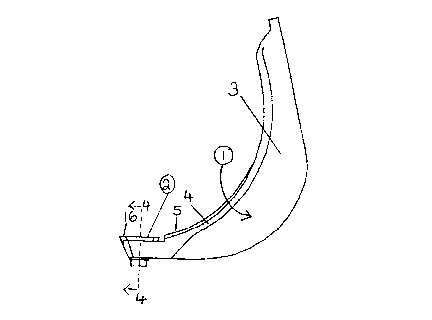Some of the information on this Web page has been provided by external sources. The Government of Canada is not responsible for the accuracy, reliability or currency of the information supplied by external sources. Users wishing to rely upon this information should consult directly with the source of the information. Content provided by external sources is not subject to official languages, privacy and accessibility requirements.
Any discrepancies in the text and image of the Claims and Abstract are due to differing posting times. Text of the Claims and Abstract are posted:
| (12) Patent: | (11) CA 2131066 |
|---|---|
| (54) English Title: | DEBARKER ARMS AND DEBARKER TIPS FOR MOUNTING ON LOG BARKING MACHINES |
| (54) French Title: | BRAS ET EXTREMITES DU DISPOSITIF D'ECORCAGE D'UNE ECORCEUSE |
| Status: | Term Expired - Post Grant Beyond Limit |
| (51) International Patent Classification (IPC): |
|
|---|---|
| (72) Inventors : |
|
| (73) Owners : |
|
| (71) Applicants : |
|
| (74) Agent: | NORTON ROSE FULBRIGHT CANADA LLP/S.E.N.C.R.L., S.R.L. |
| (74) Associate agent: | |
| (45) Issued: | 2001-01-30 |
| (22) Filed Date: | 1994-08-29 |
| (41) Open to Public Inspection: | 1996-03-01 |
| Examination requested: | 1999-08-09 |
| Availability of licence: | N/A |
| Dedicated to the Public: | N/A |
| (25) Language of filing: | English |
| Patent Cooperation Treaty (PCT): | No |
|---|
| (30) Application Priority Data: | None |
|---|
A debarker arm for a debarking machine, comprised of a crescent shaped member, a debarker arm support, an outwardly forwardly extending flange, a debarker tip receptacle, and a debarker tip seated in said receptacle, the invention comprising said outwardly forwardly extending flange extending above and forwardly of said debarker tip in the direction of incoming logs.
Bras d'écorçage pour écorceuse, composé d'un organe en forme de croissant, d'un support de bras d'écorçage, d'une bride en extension vers l'avant et vers l'extérieur, d'un réceptacle de pointe d'écorçage, et d'une pointe d'écorçage siégeant dans ledit réceptacle, l'invention comprenant ladite bride en extension vers l'avant et vers l'extérieur s'étendant au-dessus et vers l'avant de ladite pointe d'écorçage dans la direction de bûches entrantes.
Note: Claims are shown in the official language in which they were submitted.
Note: Descriptions are shown in the official language in which they were submitted.

2024-08-01:As part of the Next Generation Patents (NGP) transition, the Canadian Patents Database (CPD) now contains a more detailed Event History, which replicates the Event Log of our new back-office solution.
Please note that "Inactive:" events refers to events no longer in use in our new back-office solution.
For a clearer understanding of the status of the application/patent presented on this page, the site Disclaimer , as well as the definitions for Patent , Event History , Maintenance Fee and Payment History should be consulted.
| Description | Date |
|---|---|
| Inactive: Expired (new Act pat) | 2014-08-29 |
| Inactive: Office letter | 2007-08-27 |
| Inactive: Office letter | 2007-08-27 |
| Revocation of Agent Requirements Determined Compliant | 2007-08-27 |
| Appointment of Agent Requirements Determined Compliant | 2007-08-27 |
| Appointment of Agent Request | 2007-07-30 |
| Revocation of Agent Request | 2007-07-30 |
| Revocation of Agent Requirements Determined Compliant | 2007-04-10 |
| Inactive: Office letter | 2007-04-10 |
| Inactive: Office letter | 2007-04-10 |
| Appointment of Agent Requirements Determined Compliant | 2007-04-10 |
| Inactive: Office letter | 2007-01-29 |
| Revocation of Agent Request | 2007-01-29 |
| Appointment of Agent Request | 2007-01-29 |
| Inactive: Corrective payment - s.78.6 Act | 2007-01-18 |
| Inactive: IPC from MCD | 2006-03-11 |
| Inactive: IPC from MCD | 2006-03-11 |
| Inactive: Entity size changed | 2002-08-15 |
| Grant by Issuance | 2001-01-30 |
| Inactive: Cover page published | 2001-01-29 |
| Pre-grant | 2000-10-16 |
| Inactive: Final fee received | 2000-10-16 |
| Letter Sent | 2000-10-02 |
| Notice of Allowance is Issued | 2000-10-02 |
| Notice of Allowance is Issued | 2000-10-02 |
| Inactive: Approved for allowance (AFA) | 2000-09-14 |
| Letter Sent | 2000-03-21 |
| Inactive: Single transfer | 2000-02-23 |
| Revocation of Agent Requirements Determined Compliant | 1999-10-26 |
| Inactive: Office letter | 1999-10-26 |
| Inactive: Office letter | 1999-10-26 |
| Appointment of Agent Requirements Determined Compliant | 1999-10-26 |
| Revocation of Agent Request | 1999-10-07 |
| Appointment of Agent Request | 1999-10-07 |
| Inactive: Status info is complete as of Log entry date | 1999-08-13 |
| Letter Sent | 1999-08-13 |
| Inactive: Application prosecuted on TS as of Log entry date | 1999-08-13 |
| All Requirements for Examination Determined Compliant | 1999-08-09 |
| Request for Examination Requirements Determined Compliant | 1999-08-09 |
| Application Published (Open to Public Inspection) | 1996-03-01 |
There is no abandonment history.
The last payment was received on 2000-03-31
Note : If the full payment has not been received on or before the date indicated, a further fee may be required which may be one of the following
Please refer to the CIPO Patent Fees web page to see all current fee amounts.
Note: Records showing the ownership history in alphabetical order.
| Current Owners on Record |
|---|
| JOHNSON ENTERPRISES INC. |
| Past Owners on Record |
|---|
| DENIS JOHNSON |
| YVON JOHNSON |